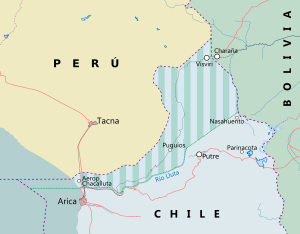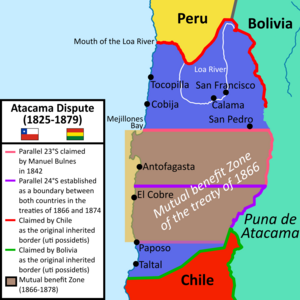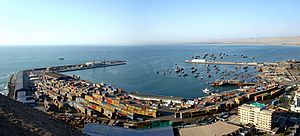Atacama Desert border dispute facts for kids
The Atacama Desert border dispute was a disagreement between Bolivia and Chile. It lasted from 1825 to 1879. The two countries argued over land along the Atacama Coast. They had different ideas about which areas belonged to them after gaining independence from the Spanish Empire. During this time, Bolivia and Chile signed two important agreements: the 1866 Treaty and the 1874 Treaty. This dispute happened before the War of the Pacific. That war finally decided who owned the land, and Chile won. Because Bolivia lost land, a new argument started between Chile and Argentina called the Puna de Atacama dispute, which was settled in 1899.
Contents
How the Dispute Started
The problem began because the borders set by the Spanish Empire were not clear. They only said that the Atacama Desert was the northern border of the Captaincy General of Chile. Historians from Bolivia and Chile disagree about whether the region of Real Audiencia of Charcas, which became part of Bolivia, included a way to the sea. Bolivians say it did, while Chileans say it did not.
When Simón Bolívar created Bolivia in 1825, he claimed access to the ocean. This was even though Chile, which became independent earlier, also claimed some of the same land. The argument grew slowly over many years in the 19th century. It was about the Atacama corridor, a part of the Atacama Desert that is now in northern Chile.
The Atacama Desert is very dry. It only rains a few times each century. This dry land is bordered by mountains: the Chilean Coast Range to the west and the Andes to the east. The dry geography played a big part in how the dispute began.
After Chile (1818) and Bolivia (1825) became independent, their governments did not immediately define their borders. This changed when valuable minerals like nitrate, silver, and copper were found in the Atacama region. Both Bolivia and Chile then claimed the land.
Other countries became interested because nitrates were important for making fertilizer and explosives. Countries like Britain, Spain, and the United States had economic reasons to want control over these resources. They supported different sides in the dispute.
Chile's influence in the area grew. Miners, often supported by Chilean and foreign companies, moved north. They built mines and port facilities. Most of the mining along the coast was done by Chilean companies and British businesses. This was because Chile had a stronger economy and more stable government.
Boundary Treaty of 1866
The borders in the region were not clearly agreed upon until 1866. In that year, Bolivia and Chile signed a treaty. It set the 24th parallel south as their border. The treaty also said that both countries would share the tax money from minerals shipped out of the area between the 23rd and 25th parallels.
The War of the Pacific Begins
On November 27, 1873, a company called Antofagasta Nitrate & Railway Company signed a contract with the Bolivian government. This contract allowed the company to dig up saltpeter without paying taxes for 25 years.
A second treaty was signed in 1874. This new treaty replaced the 1866 one. It allowed Bolivia to collect all the tax money from the area between the 23rd and 24th parallels. But it also said that tax rates on Chilean companies could not increase for 25 years.
In February 1878, the Bolivian Congress decided that the 1873 contract was not complete. It had not been approved by Congress, as required by Bolivia's constitution. So, Congress would only approve the contract if the company paid a new tax of 10 cents for each unit of mineral it took out.
Chile argued that the 1874 border treaty did not allow for such a tax increase. The company complained that the new payments were illegal. The company put a lot of pressure on Chile and asked the Chilean government to step in.
When the Antofagasta Nitrate & Railway Company refused to pay, the Bolivian government, led by President Hilarión Daza, threatened to take over the company's property. Chile responded by sending a warship to the area in December 1878. Bolivia then announced it would seize and sell the company on February 14, 1879. Chile warned that such an action would make the border treaty invalid.
In 1873, Peru and Bolivia had signed a secret agreement called the Treaty of Mutual Defense. In April 1879, after learning about this secret alliance, Chile declared war on both Bolivia and Peru. Within four years, Chile defeated both countries. This led to Chile taking over Peru's Tarapacá department and Arica province. Chile also took Bolivia's Litoral department, which left Bolivia without a coastline.
In 1884, Bolivia signed a truce. This agreement gave Chile control of the entire Bolivian coast, including the province of Antofagasta. This area had valuable nitrate, copper, and other mineral deposits. The two countries signed the Treaty of Peace and Friendship in 1904, making this arrangement permanent. Chile built a railroad connecting Bolivia's capital, La Paz, to the port of Arica. Chile also promised that Bolivian goods could pass freely through Chilean ports and land.
Chile's 1975 Proposal

In 1975, the Chilean government, led by Augusto Pinochet, made an offer to Bolivia. Chile proposed to give Bolivia a narrow strip of land from the sea to the border between Chile and Bolivia. This strip would run next to the border between Chile and Peru. In return, Bolivia would give Chile the same amount of its own land.
This proposal was known as the Charaña Accords. However, the land Chile offered had once belonged to Peru. According to the treaty of Ancón, Chile could not give former Peruvian lands to other nations without Peru's agreement. Peru's leader, Francisco Morales-Bermúdez, did not like these changes. He suggested that Arica become a territory governed by all three states. Chile said it could not accept such a complicated shared control. Some experts believe Pinochet knew the proposal would fail because of Peru's opposition. They think he made the offer just to show goodwill to Bolivia.
Recent History of the Dispute
Bolivia still wants a way to the Pacific Ocean through the Atacama Desert. Chile, however, does not agree to this. Despite the disagreement, Chile allows all kinds of Bolivian goods to pass freely through its ports in the Atacama region. The lands that Bolivia and Peru gave to Chile have some of the world's largest copper deposits. These mines are run by Codelco, a state-owned mining company. The money from this mining provides a large part of Chile's government income.
During the Bolivian Gas War, the dispute came up again. Most Bolivians, including Evo Morales (who later became president), did not want Bolivian gas to be exported through Chilean land. The government and foreign companies wanted to do this. In 2004, on the anniversary of the 1904 treaty, Bolivia's claims for sea access were renewed. The phrase "gas-for-sea" became a popular slogan for those against exporting gas through Chile.
The dispute became very clear when Bolivian president Carlos Mesa had a public argument with Chilean president Ricardo Lagos at the Organization of American States. Mesa, feeling pressure to speak about Bolivia's desire for sea access, brought the topic up to all the presidents of the Americas. The Chilean president reacted by mentioning that Bolivia refused to have diplomatic relations with Chile. He then offered to establish diplomatic relationships between the two countries "here and now." Mesa quickly turned down the offer. He was not looking for an offer but wanted to get international attention for the situation.
Bolivian president Evo Morales later decided to stop all talks with Chile about the sea issue. Instead, he chose to take the matter to international courts. This went against a 2012 resolution from the OAS, where most member states encouraged Bolivia to talk directly with Chile. Chilean president Sebastian Piñera asked Evo Morales to continue the talks, but it did not work. The Bolivian government went ahead and filed a case with the International Court of Justice on April 24, 2013.
Surprisingly, the case did not challenge the border treaties that Evo Morales had always been against. Instead, the case was based on two talks in the 1970s and 1950s. Bolivia claimed that Chile had promised a sovereign route to the Pacific during these talks, but it never happened. Bolivia argued for "the rights of expectations" in their case. This is a business law term that had never been used in the International Court of Justice before. In October 2018, the International Court of Justice made a final decision. It ruled that Chile was not required to negotiate giving Bolivia sea access.
In March 2021, Bolivian president Luis Arce, on Día del Mar (Sea Day), said that the dispute is "open and pending" between the two countries. He offered a nine-point plan to start diplomatic talks with Chile to solve the problem. The Chilean government replied that it was willing to talk, but that the issue had already been settled by the International Court of Justice. During the 2021 Chilean presidential campaign, communist candidate Daniel Jadue spoke in favor of a "mutually beneficial" agreement with Bolivia. This would involve giving some land in exchange for Chile getting some gas and water rights. Jadue later clarified that he would only support such a plan if the public voted for it in a special election.
See also
 In Spanish: Disputa limítrofe del desierto de Atacama para niños
In Spanish: Disputa limítrofe del desierto de Atacama para niños
- Anti-Chilean sentiment
- Bolivia–Chile relations
- Puna de Atacama dispute
- Chilean–Peruvian territorial dispute



